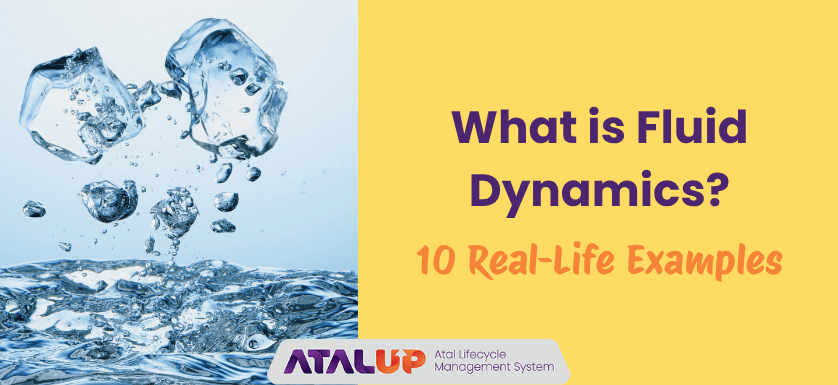
Have you ever watched water swirl down a drain or seen smoke rise into the air? These everyday moments are not just random. They are real-life examples of something called fluid dynamics. Let’s break it down simply.
What is Fluid Dynamics?
Fluid dynamics is the study of how liquids and gases move. The word “fluid” includes both water-like substances (liquids) and air-like substances (gases). So, when water flows through a pipe or wind moves around buildings, fluid dynamics is at work.
Scientists and engineers use fluid dynamics to understand things like ocean currents, airplane flight, blood flow in our bodies, and even how perfumes spread in the air.
Now, let’s look at 10 fluid dynamics examples you can easily relate to.
10 Real-Life Fluid Dynamics Examples
1. Water Flowing from a Tap
When you open a tap, water starts to flow out. The speed, direction, and shape of the water stream change based on how wide the tap is or how much pressure is behind it. This is one of the simplest examples of fluid dynamics in action.
2. Drinking with a Straw
When you suck air from the straw, it creates low pressure inside. The atmospheric pressure pushes the drink up into your mouth. This movement of liquid due to a pressure difference is explained by fluid dynamics.
3. Blood Circulating in the Body
Your heart pumps blood through your veins and arteries. The speed and pressure of blood change as it flows through narrow or wide blood vessels. Doctors and scientists use fluid dynamics to understand and treat blood flow problems.
4. Wind Moving Around Buildings
When wind hits a building, it changes direction and speed. Sometimes it flows around the sides or over the top. Architects use fluid dynamics to design buildings that can handle strong winds and stay stable.
5. Smoke from a Candle
Light a candle and blow it out. You’ll see smoke rising and twisting in the air. That smooth or swirling motion of smoke is a type of fluid flow called laminar or turbulent flow. Fluid dynamics helps explain why smoke behaves that way.
6. Swimming or Rowing in Water
When you swim or row a boat, you push water backward to move forward. The way water pushes back on your hands or the oars is part of fluid motion. Sports engineers study this to design better swimsuits, boats, or training techniques.
7. Airplane Wings and Flight
When an airplane takes off, air flows faster over the curved top side of the wings. This causes lower pressure above the wing and higher pressure below, lifting the plane upward. This is known as Bernoulli’s principle, a key idea in fluid dynamics.
8. Perfume Spreading in a Room
When you spray perfume, the liquid turns into tiny particles and mixes with the air. Over time, the scent spreads throughout the room. This process is called diffusion and is explained by fluid dynamics and gas behavior.
9. Boiling Water and Steam Movement
When water boils, bubbles form and rise to the surface. Steam escapes and spreads in the air. All these movements are due to changes in temperature, pressure, and fluid behavior.
10. Rainwater Draining from Roads
After heavy rain, you’ll notice water flowing through roadside drains. Civil engineers use fluid dynamics to design drainage systems so water doesn’t flood the roads or homes.
Learn Fluid Dynamics in Real Time at Atal Tinkering Labs
Understanding how fluids move might seem tough in books, but it becomes fun and easy when students try it out themselves. That’s what Atal Tinkering Labs (ATLs) are all about. ATLs are set up in schools to promote hands-on STEM learning.
Students can perform experiments like building mini wind tunnels, observing water flow in different pipes, or creating small boats to test water resistance. These activities help them understand real science using simple tools.
Atal Tinkering Labs encourage creativity, problem-solving, and scientific thinking by letting students explore physics in action.
Let ATALUP Make it Easier for Schools
Running a successful ATL lab takes planning and effort. ATALUP is a helpful platform that supports schools in everything, from applying for ATL grant applications to organizing STEM activities and tracking progress. With ATALUP, schools can make sure their ATL labs are not just built, but are active, exciting, and useful every day.
ATALUP not only has offered a platform for schools to start and manage their ATLs, but also has launched a STEM mobile app where students can perform interesting STEM activities and learn fluid dynamics, centripetal force, centrifugal force, and more in a fun way.
Download the app now
Android: Play Store and iPhone: Apple Store
Final Thought:
Fluid dynamics is not just for scientists. It is around us all the time. From brushing your teeth to flying in a plane, fluids are in motion. With the right tools and platforms like ATALUP and Atal Tinkering Labs, students can learn these concepts in a way that is clear, fun, and unforgettable.